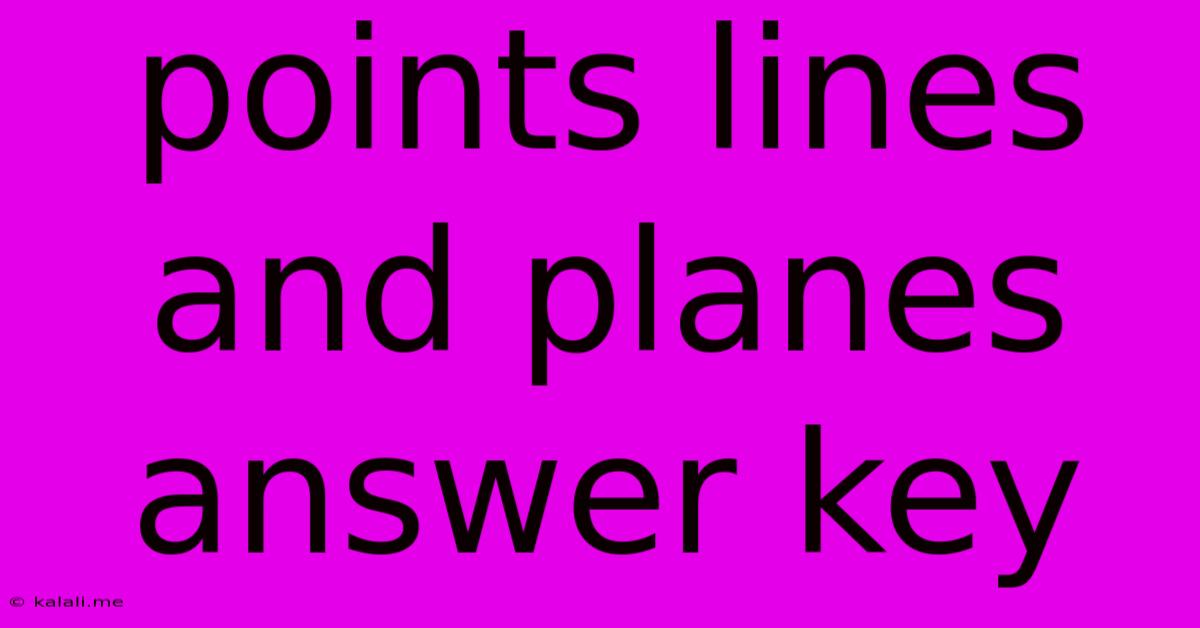Points Lines And Planes Answer Key
Kalali
May 09, 2025 · 3 min read

Table of Contents
Points, Lines, and Planes: A Comprehensive Guide with Answers
Understanding points, lines, and planes is fundamental to geometry. This article provides a clear explanation of these concepts, along with example problems and answer keys to solidify your understanding. This guide is perfect for students needing to grasp these core geometric principles and master related problem-solving. We'll cover definitions, properties, and applications, ensuring a comprehensive understanding of this essential topic.
What are Points, Lines, and Planes?
Geometry relies heavily on three fundamental building blocks: points, lines, and planes. These are undefined terms, meaning their definitions are based on intuitive understanding rather than formal mathematical definitions. Let's explore each one:
-
Point: A point is a location in space. It has no size or dimension, only position. We represent it graphically as a dot and label it with a capital letter (e.g., point A).
-
Line: A line is a straight path extending infinitely in both directions. It is defined by two distinct points and has infinite length but no width or thickness. We represent a line with a lowercase letter (e.g., line l) or by naming two points on the line (e.g., line AB). A line segment is a part of a line with two endpoints.
-
Plane: A plane is a flat surface extending infinitely in all directions. It has two dimensions (length and width) but no thickness. A plane can be defined by three non-collinear points (points that do not lie on the same line). We often represent a plane as a parallelogram or a shaded region.
Key Properties and Relationships
Several important relationships exist between points, lines, and planes:
-
Collinearity: Points are collinear if they lie on the same line.
-
Coplanarity: Points and lines are coplanar if they lie on the same plane.
-
Intersection: The intersection of two lines is a point (unless they are parallel). The intersection of a line and a plane is a point (unless the line lies within the plane). The intersection of two planes is a line (unless they are parallel).
-
Parallel Lines: Two lines are parallel if they lie in the same plane and never intersect.
-
Parallel Planes: Two planes are parallel if they never intersect.
Example Problems and Answers
Let's work through some example problems to solidify your understanding:
Problem 1: Are points A, B, and C collinear?
(Diagram showing points A, B, and C on a straight line)
Answer: Yes, points A, B, and C are collinear because they lie on the same line.
Problem 2: Are lines l and m parallel?
(Diagram showing two lines l and m that never intersect and appear to be in the same plane)
Answer: Yes, lines l and m appear to be parallel because they lie in the same plane and do not intersect. (Note: Visual inspection is not definitive proof; a formal geometric proof would be needed for complete certainty.)
Problem 3: Describe the intersection of plane P and line n.
(Diagram showing a plane P and a line n intersecting at a single point)
Answer: The intersection of plane P and line n is a point.
Problem 4: How many planes can contain three non-collinear points?
Answer: Only one plane can contain three non-collinear points.
Problem 5: True or False: Two parallel lines can intersect.
Answer: False. Parallel lines, by definition, never intersect.
Conclusion
Understanding points, lines, and planes is crucial for building a solid foundation in geometry. By mastering these basic concepts and practicing problem-solving, you'll be well-prepared to tackle more advanced geometric concepts. Remember to visualize these concepts, and don't hesitate to use diagrams to aid your understanding. Further exploration into axioms and postulates will provide a deeper theoretical understanding of these fundamental geometric elements.
Latest Posts
Latest Posts
-
127 Out Of 150 As A Percentage
May 09, 2025
-
How Does The Respiratory System Work With The Digestive
May 09, 2025
-
Is 41 A Prime Number Or A Composite Number
May 09, 2025
-
What Is 76 Of An Hour
May 09, 2025
-
How Long Is 55cm In Inches
May 09, 2025
Related Post
Thank you for visiting our website which covers about Points Lines And Planes Answer Key . We hope the information provided has been useful to you. Feel free to contact us if you have any questions or need further assistance. See you next time and don't miss to bookmark.